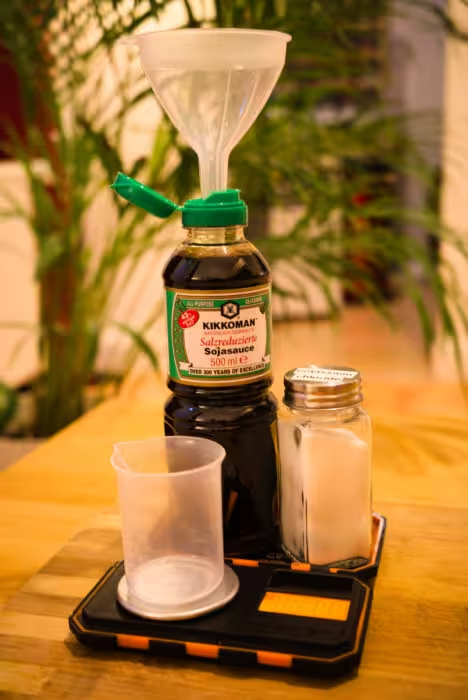Potassium fortified Kikkoman soy sauce
Published August 20th, 2022 under Food
For a long time I’ve had a slightly elevated blood pressure. This isn’t a big deal, but it makes me careful about consuming foods with very high levels of sodium. This has always caused me issues with soy sauce, as it’s absolutely drenched with salt. My favourite soy sauce is Kikkoman soy sauce and they do have a low sodium version, but it’s not as tasty as the regular Kikkoman and I tend to just use more of it to compensate.
The issue of sodium in soy sauce is not the only piece of the puzzle however. Instead of reducing the amount of sodium in the diet, it is also possible to increase potassium consumption to counteract the sodium. The levels of sodium in the body are partially controlled by the balance of sodium to potassium in the body. If the potassium levels are increased, the sodium levels will drop accordingly.
I did an experiment involving using potassium instead of sodium in my food in 2016 by replacing sodium chloride on my popcorn with potassium chloride. They both taste salty, however the potassium taste in the popcorn was overwhelming. That experiment was failure, but I eventually found one which does work!
Note: Potassium chloride used for this should be food grade! Don’t grab some random lab chemical for the task lol.
Popular “salt” replacements, often use a mixture of sodium chloride and potassium chloride as the mixture is apparently significantly less detectable to the human palate than potassium chloride on it’s own. With this in mind, I decided to run an experiment to see what would happen if I fortified Kikkoman soy sauce with potassium chloride.
To do this, I bought a 500 mL bottle of Kikkoman reduced sodium soy sauce. I chose the low sodium version so that I could simply replace the sodium chloride which was already missing from it, with potassium chloride. This way it kept the same level of “saltiness”, but with a much healthier ratio of sodium to potassium. I calculated the amount of sodium chloride missing between the reduced sodium and regular sauces, and weighed that much potassium chloride out. The amount of potassium chloride required per 100 mL, was 6.3 g. I poured the potassium chloride through a funnel into the bottle and shook it until it dissolved.
I can personally tell the difference between regular Kikkoman and my potassium fortified Kikkoman soy sauce, but it’s not clear to me that the regular Kikkoman tastes better. They just taste different.
I ran some crude blind taste tests on some friends of mine. Out of three people, one said the potassium fortified one was not very good, another said it was not quite as nice as the regular Kikkoman and another couldn’t tell the difference. So based on this, it seems that I haven’t created some master piece which the world of soy sauce should definitely copy, but I do think this could be super useful for anyone with a penchant for soy sauce, but also an elevated blood pressure problem.
And friendly people at Kikkoman, if you are out there reading this, feel free to copy my idea! It’d save me having to make it myself 😉
| per 100 mL | Sodium | Potassium |
| Regular Kikkoman soy sauce | 6760 mg | 0 mg |
| Kikkoman reduced sodium soy sauce | 3639 mg | 0 mg |
| Potassium fortified Kikkoman soy sauce | 3639 mg | 3304 mg |

Kikkoman soy sauce 150 mL serving vessel

Fortifying Kikkoman soy sauce with potassium

Nina says:
Sweet (or should I say salty 😁)
I like you come up with hacks like this. I would kind of never thought of it, but it kind of makes sense.
August 21, 2022 at 2:07 am # //
Tacy says:
Did you do a study to see how it affected your blood pressure?
November 10, 2024 at 4:09 pm # //
Ryan Hellyer says:
No. It’s just potassium, so should behave the same way that potassium normally does with blood pressure.
May 1, 2025 at 8:42 am # //